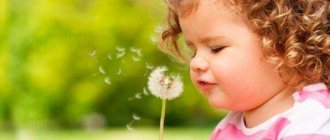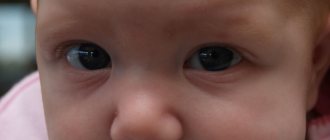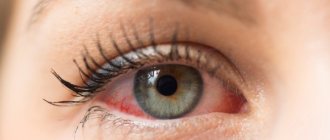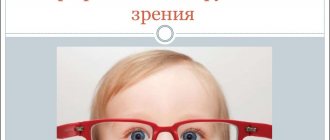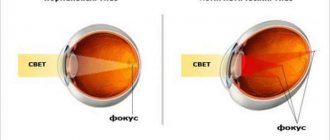Features of the eyes in newborns
The eyes of a newborn are especially susceptible to infection.
A baby's eyes differ from adults not only in structure. They are not sufficiently adapted and formed. Their peculiarity is that newborns are farsighted, cannot focus their gaze, and have weak eye muscles.
Very often the eyes of infants become inflamed. Causes of inflammation:
- bacteria,
- viruses,
- allergens.
Manifestations of the disease: the eyes become red, swollen, watery, and pus appears. It is important to get treatment in time to prevent the infection from spreading.
Most often, a baby is diagnosed with conjunctivitis and dacryocystitis:
- Conjunctivitis is characterized by increased lacrimation, swelling of the eyes and nose, and the appearance of purulent discharge. It is important to know that the disease is caused by viruses and bacteria in order to prescribe the correct treatment.
- Dacryocystitis develops when there is a blockage (film) of the nasolacrimal duct. Tears stagnate in the lacrimal sac, the eyes become sticky, and purulent discharge appears.
For these diseases, rinsing is prescribed.
Eye care for conjunctivitis
Conjunctivitis is an inflammation that can be divided into two types. Infectious is when the baby gets dirt into his eyes. Viral – when accompanied by colds (ARVI, acute respiratory infections or influenza).
If you notice that a child’s eyelids are sticking together and pus is constantly collecting in the corner of the eye, then this is conjunctivitis. It is easy to treat; it is enough to instill special children's drops containing an antibiotic for three days. If the baby's mother has milk, you can drop it with breast milk, or wipe it with a napkin soaked in milk. You can just spray it in the corner of your eye and blot it.
Washing with a solution of chamomile, potassium permanganate or furatsilin helps a lot. It is necessary to apply the drops to both eyes, even if one is festering. If treatment does not help, then you should not delay, but consult a specialist doctor. In advanced stages, antibacterial ointments and antibiotic solution are used.
This infection is transferable, so it is better to avoid contact with sick children.
General rules for washing
For rinsing, you can use either boiled or purchased purified water.
In order for the rinsing procedure to be effective and not cause harm, you need to follow some rules. The eyes are carefully washed (preferably after sleep). You can use a cotton pad, boiled water and a gauze cloth. If there are no signs of inflammation, clean boiled water is sufficient.
Dip a cotton pad in water, wring it out a little and wipe the eye from the outer to the inner corner. The remaining water is removed with a gauze cloth. The same needs to be done with the second eye.
Take only boiled water: running water contains a lot of bacteria.
Before the procedure, hands are thoroughly washed with soap.
Daily hygiene
From the first days of life, a newborn needs to wipe his eyes with a cotton pad (swab) moistened with water. This must be done in the morning, since after sleep a white lump of discharge often appears in the inner corner. During the day, you can wipe your eyes 1-2 times as needed (after a nap, a walk, to remove street dust).
The immunity of young children is weak, so it is necessary to ensure clean and humidified air in the room where the newborn is located - this will serve as the prevention of diseases of the organs of vision.
The baby has no tears, since the protective reflex has not yet formed; the corresponding nerve centers are in the development stage for up to 1-2 months. Rubbing the eyes in this case moisturizes them.
The visual organs of a newborn should be treated correctly:
- 1. Prepare a container of boiled water at room temperature or close to body temperature and cotton pads (they are preferable to cotton wool because they do not leave lint on the skin). Wash the hands.
- 2. Place the baby on his back on the changing table.
- 3. Soak two cotton pads in water and squeeze lightly. One is used for each eye.
- 4. In the direction from the outer corner to the inner, it is easy to rub each eye without pressure. The child's head should be slightly turned towards the treated area.
- 5. If there is any moisture left on the skin, pat it dry (do not rub).
There is no need to skimp on cotton pads: even if the material seems clean after wiping, you should use another one for the other eye. Do not use wet wipes on your hands and body. The substances they contain cause irritation to the mucous membrane. You should not use any drops, products (Furacilin, potassium permanganate, tea leaves, saline solution) or herbal decoctions for wiping without the recommendation of a pediatrician or ophthalmologist. In the absence of redness, inflammation, or suppuration, nothing other than boiled water is indicated.
Some mothers advise putting breast milk in the baby's eyes, considering it the most sterile liquid. This is absolutely impossible to do, since only the substance in the breast does not contain bacteria. In the air, it becomes a favorable environment for the proliferation of microorganisms, so it can provoke an ophthalmological disease.
Once your baby's umbilical wound has healed and he can bathe, his eyes will flush and moisten on their own. From 2-3 months, the baby washes his face and hands several times a day, and there is no need for wiping.
Washing out festering eyes
From pharmaceutical products for rinsing, Furacilin solution is often used; you should only buy it ready-made, and not in tablets, since if you prepare it yourself, particles of the medicine may remain.
Purulent discharge appears due to:
- neglect of hygiene rules (infection);
- appearance of a foreign body;
- eye diseases (conjunctivitis, dacryocystitis).
Simple water is not enough to wash purulent eyes. Drugs with antimicrobial and anti-inflammatory effects are needed. There are several means:
- Without consulting a specialist, you can use an ancient folk remedy - tea leaves. Despite its harmlessness, it can cause harm: too hot can cause a burn. It is better to take warm, medium-strength tea leaves
- Chamomile decoction, like tea leaves, is used not hot and not strong.
Before washing, wash your hands well with soap. A clean cotton swab is moistened in the chosen product and wiped the eye according to the rules. This procedure is done at least once a day. Some experts recommend applying gentle pressure to the tear duct to squeeze out all the contents.
There is controversy regarding the use of breast milk for lavage. Some believe that milk is very healthy and sterile; it cleans the eyes well. Others claim that it contains many nutrients, which promotes the growth of bacteria even more.
Is it possible to wash a newborn's eyes with green tea?
Rinsing your eyes with tea leaves helps relieve fatigue when working at the computer, remove puffiness and dark circles under the eyes. Tea saves you from foreign bodies and dust, and helps in the complex treatment of some eye diseases, subject to mandatory consultation with an ophthalmologist.
What tea is better for rinsing?
Black, green, yellow teas and their mixtures are used to wash the eyes.
The most effective and potent varieties are considered to be long leaf (tea consisting of individual tea leaves) and large-leaf varieties. But teas with additives and flavorings should be treated with caution. Often, artificial additives or inappropriate components cause allergies and aggravate the painful condition.
To wash your eyes, you can use tea mixtures containing natural additives:
- pharmaceutical chamomile;
- rosehip;
- linden;
- bird cherry flowers;
- thyme (thyme).
How is it useful?
All types of tea have pronounced bactericidal and bacteriostatic (inhibiting the proliferation of bacteria) properties, contain substances that help relieve swelling and improve the condition of the mucous membranes, and increase skin turgor.
How to use tea leaves correctly?
- First of all, the tea must be brewed correctly.
- There are several ways:
- To avoid tea leaves or tea dust from getting into your eyes, be sure to strain the tea leaves through a strainer or several layers of gauze.
Important! You cannot use tea leaves that have stood for more than two days. It becomes acidic and bacteria begin to multiply rapidly.
The brew is ready, you can start washing your eyes. To carry out the procedure you will need:
- welding;
- small basin or bowl;
- soft natural fabric or paper napkins;
- a cotton ball (disk, stick, sponge, gauze pad) individual for each eye;
- cape to protect clothes from tea drops.
Depending on the indications, there are several options for washing eyes with tea:
Treatment of diseases
Eye rinsing with tea is indicated for:
- prevention of excessive tearing;
- redness of the corners of the eyes, which serves as a warning about the possibility of several diseases (canaliculitis, dacryocystitis, obstruction of the lacrimal ducts, blepharitis, angular and allergic conjunctivitis, computer vision syndrome);
- before using ophthalmic medications;
- if foreign bodies or chemicals come into contact with the eyes.
Selection of medications for a newborn
The most popular and simple remedy for washing the eyes of a newborn is chamomile infusion.
When selecting medications, you need to be careful. It is advisable to consult with your treating pediatrician. Doctors usually prescribe the following.
- Furacilin is an antimicrobial agent. Release form: tablets and aqueous solution. Since the tablets do not dissolve well, they are first thoroughly crushed. One crushed tablet is mixed with 100 ml. boiled water. The resulting solution is stored for no more than a day, the next day a new one is diluted.
- Potassium permanganate solution - it should be a weak pale pink without visible crystals. Just two or three crystals per glass of boiled water are enough.
- Boric acid solution (2%) – 1 tsp. acids are diluted in a glass of water. Each eye is washed with a clean cotton swab.
Eye drops are used as prescribed by a doctor. Open the bottle with clean hands.
The tip of the pipette should not come into contact with anything.
Holding the baby's head firmly (he may jerk and get hurt), pull down the lower eyelid. Without touching the eyeball, drop a drop between the eyeball and the eyelid. The baby must blink so that the medicine spreads over the eye. Do the same with the second eye.
Typically, the following eye drops are prescribed to eliminate inflammation in newborns.
- Albucid is an antimicrobial agent that can be used from birth. The active substance is sulfacetamide.
- Tobrex – active ingredient tobramycin. According to the instructions, it is not used for babies under one year of age, but in practice, doctors prescribe drops for infants.
- Vitabact is an antiseptic, indicated for use from birth. Prescribed for dacryocystitis.
- Oftalmoferon is a combination drug with a wide spectrum of action.
The dose and duration of treatment are prescribed by the local pediatrician. There is no need to self-treat, otherwise you may harm the baby.
Preventing eye infection in a newborn
Inflammatory processes in the eyes can be prevented by following preventive measures:
- The eyes are washed twice a day with a sterile bandage moistened with boiled water;
- if one of the family members gets sick, he is obliged to use disposable masks so as not to infect the baby;
- Every time you touch a baby, you should wash your hands with soap.
Eye washing is one of the hygiene procedures. Preventive measures will help avoid eye diseases. Inflammatory processes must not be started, otherwise serious pathologies may develop.
In the video below you will find a detailed description of proper eye care for a newborn:

